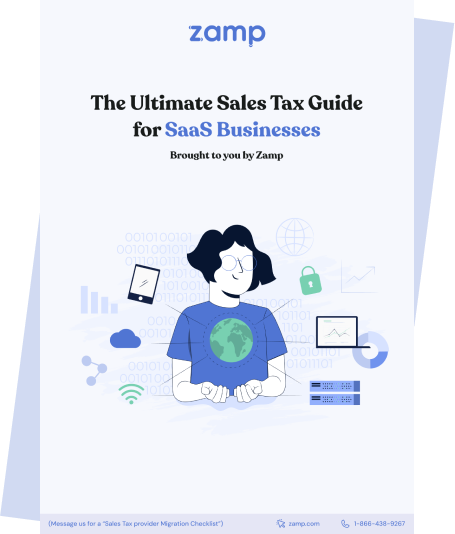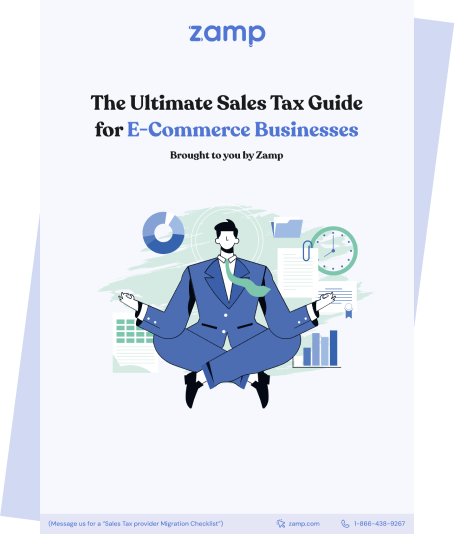How to Automate Sales Tax Compliance
Sales tax filing and compliance can significantly drain your time and resources. Discover how to automate sales tax filing and compliance for your business.
Learn MoreZamp Learnings:
- Each state, city, and county has its own sales and use tax rates and economic nexus thresholds, making it difficult to manage sales tax manually.
- Automating sales tax filing and compliance ensures accuracy, efficiency, and compliance for your business.
- Zamp is the first managed sales tax solution on the market that manages the complete sales tax lifecycle.
Have you ever considered how much time you spend on sales tax filing and compliance? As a business owner, you're likely juggling numerous responsibilities, and the complex, ever-changing world of sales tax might drain your resources significantly.
Automating your sales tax filing and compliance can not only reduce the time spent on this area of your business but also ensure accuracy and adherence to all relevant regulations. We’ll discuss the benefits and more in the sections below.
Book Your Consultation
30-minute call
sales tax expert
off your plate
What Is Sales Tax Automation?
As an online business, you can easily reach a sales tax nexus threshold through the number of transactions conducted in a state or a specific revenue amount. Every transaction that goes through your storefront requires sales tax calculation to ensure the right amount is charged to the customer.
These calculations tend to be based on your customer’s location, business location, the specific type of goods or services, and the sales price. After collecting sales tax from your customers, you must file and remit it by the due date given to you by each state.
Zamp Tip
Sales tax automation solutions simplify all of this for you. They can handle sales tax compliance, which typically includes nexus monitoring, filing, and remittance. This can save you time and also avoid errors of handling compliance manually.
Benefits of Sales Tax Automation
With sales tax software taking care of your sales tax calculations, you'll have more time to focus on the core aspects of your business. The main benefits of using sales tax automation software are:
- Accuracy: Automated sales tax reporting filing ensures correct tax rates are applied consistently across transactions.
- Efficiency: Tax automation accelerates the tax calculation and filing process.
- Compliance: An automated sales tax solution keeps up-to-date with changing tax laws.
Industries Using Sales Tax Automation Software
Many industries, from e-commerce to consumer packaged goods (CPG) companies, are adopting automated sales tax filing and compliance. Even within the digital space, sectors like Software as a Service (SaaS) and other digital services are using sales tax automation for efficiency and compliance.
Sales Tax Automation for E-Commerce Businesses
In the realm of e-commerce sales tax, automating sales tax filing and compliance is becoming an integral part of business operations. Here's how automation can benefit your e-commerce business:
- Automation speeds up the process of preparing and filing your sales tax returns.
- Manual data entry is eliminated, which reduces the risk of errors for your tax obligations.
- Real-time tax calculation means you're charging your customers the correct amount of sales tax.
- Tax rates are updated automatically.
- Accurate sales tax reporting guards against auditing issues.
Sales Tax Automation for Consumer Packaged Goods Companies
With many products distributed across various states, each with differing tax regulations, managing sales tax for consumer packaged goods (CPG) companies can become complex.
Sales tax software can handle the bulk of the work by accurately calculating sales tax based on the product, location, and other variables. This will save you time and reduce the risk of errors. You'll also comply with all local, state, and federal tax laws. That's why more and more CPG companies are turning to automation for their sales tax needs.
Sales Tax Automation for Digital Services
Industries in the digital space are also harnessing the power of sales tax automation to enhance their compliance efforts and operational efficiency.
SaaS and software companies are leveraging sales tax automation tools to:
- Accurately calculate sales tax rates, eliminating the risk of charging incorrect amounts.
- Automate tax return preparation, saving time and reducing manual errors.
- Determining sales tax on digital goods.
- Stay in compliance by staying up-to-date with changing tax laws.
- Determine when and where they're required to collect sales tax. For example, states are split on whether they require software providers to collect sales tax on SaaS.
- Simplify the tax remittance process.
Free Download: Sales Tax Guide for SaaS

How to Automate Your Sales Tax Compliance
Staying sales tax compliant is no easy feat. There are several steps involved in the sales tax compliance process, but using automation software can make it easier. Each of the steps listed below can be automated. Let’s dive in.
1. Sales Tax Nexus Monitoring
Businesses must register to collect state sales tax when they hit a certain threshold, often called economic nexus. These thresholds are usually based on revenue, transaction, or a combination of both. Since sales tax is governed at the state level, these thresholds vary nationwide. There are also local tax jurisdictions that have their own rules as well.
For example, California’s economic nexus threshold is $500,000, while Florida’s is $100,000. In addition, some states, like Georgia, have transaction and revenue limits.
Companies can also have nexus if they have a physical presence in a state. This could include:
- Location: Having an office, warehouse, or other place of business in a state and storing goods in a warehouse.
- Employees: Employees, contractors, salespeople, or any other kind of worker in a state creates physical nexus.
- Events: This can include selling goods or services at a trade show or other event.
Manually monitoring your sales tax nexus thresholds can be time-consuming, especially as your business grows. You not only have to track your sales manually but also research each state’s thresholds and guidance. When you hit a new threshold in a state, you must register immediately to begin collecting taxes.
Sales tax automation software handles all the work by constantly monitoring the sales you generate in each state.
2. Registering Your Business
Once you’ve reached a threshold in a state, you’ll need to register for a sales tax permit. Each state has different rules and regulations, and you must register to collect sales tax from your customers.
Since each state has its own forms and processes, manually registering for sales tax permits can take significant time. Many of the best sales tax solutions handle registration when you meet a new nexus threshold.
3. Sales Tax Calculation and Collection
In the US, there are over 13,000 tax jurisdictions, with each state setting its own sales tax rates. However, many local jurisdictions also have sales tax rates at the county, municipal, and district levels. When a customer is in the checkout process, the sales tax rate would include the statewide sales tax rate and any local sales tax rates.
In addition, five states do not have statewide sales tax — Alaska, Delaware, Montana, New Hampshire, and Oregon. Local sales tax may still apply in these states.
You must research each state and local jurisdiction and apply the tax manually. This is why sales tax compliance solutions are beneficial, as they handle everything for you. Charging the incorrect sales tax amount can get you into trouble with the states, often resulting in you paying the difference out of pocket following a sales tax audit.
Further, sales tax rates change constantly. A sales tax engine will automatically apply any changes that happen, whether at the state or local level.
4. Sales Tax Filing and Remittance
After collecting sales tax from your customers, you must file a sales tax return and remit the tax owed to the state or local tax authorities. Each state’s Department of Revenue or tax authority website will have details on how to file along with due dates. Due dates vary by state and the frequency in which you’re required to file may also vary by state.
Zamp Tip
If you have not filed sales tax during a reporting period, you will likely still need to file a “zero return.” Keep in mind that each state has its own rules regarding filings and remittances, so it’s best to speak with a sales tax expert if you need advice.
Free Download: Sales Tax Guide for E-Commerce

How to Find the Right Sales Tax Filing and Compliance Software
Understanding your organization's unique needs and challenges is crucial in finding the best solution to automate your sales tax filing and compliance requirements. Consider your industry-specific requirements, current pain points, and business needs to select an API and integration-friendly solution.
What to Consider With Sales Tax Automation Software
Every industry comes with its own set of unique sales tax rules and regulations, which means you need to consider the following:
| Type of goods and services | Different products may have different tax rates or exemptions. For example, physical goods may be taxed differently than digital goods, and essential goods may be taxed differently than luxury goods. |
| Geographical location | Sales tax laws vary significantly from state to state and even city to city. For instance, destination-based vs. origin-based sales tax or sales tax by city or county. |
| Your customers | Whether you're selling to businesses (B2B) or consumers (B2C) can also affect how sales tax is applied. To illustrate, retail sales vs. wholesale sales or tax exemption status for certain customers. |
Current Business Needs and Pain Points
It's also important to closely examine your organization's unique challenges and needs in sales tax filing and compliance.
Delve into the current pain points in your process. Are you spending too much time and resources on manual data entry? Are errors cropping up due to lack of expertise or oversight? Perhaps the rapidly changing tax laws are overwhelming your team.
Additionally, consider your specific business needs. Does your organization operate in multiple states or countries, thereby dealing with complex, varied tax regulations? Or maybe you're planning to scale up across multiple channels soon, making a more streamlined, automated tax process crucial.
Identifying these issues and requirements is key to finding the best automation solution for your organization.
Selecting an Integration-Friendly Solution
Now that you understand your organization's unique needs and challenges, you can select a sales tax automation solution that addresses these issues and seamlessly integrates with your existing systems and processes. Consider these factors:
Compatibility:
- Ensure the solution is compatible with your existing software and hardware.
- Check if it supports your current operating system.
- Determine if it's compatible with your accounting and invoicing software.
Scalability:
- Choose a solution that grows with your business.
- Look for features that are built to handle increasing tax complexities.
- Ensure it can handle the workload as your sales volume increases.
Support:
- Opt for a solution backed by excellent customer support.
- Prioritize vendors that offer 24/7 assistance and phone support.
- Consider the availability of training and resources for smooth implementation.
Onboarding of Employees and Stakeholders
After you've selected your sales tax automation solution, you'll need to get your team and key stakeholders on board. They need to understand the features and benefits and how this solution aligns with your organization's needs and challenges.
Hear them out if they have any worries or wrong ideas. Stay patient and really listen to their input – it can be a goldmine for making the system even better.
Incorporation of Existing Workflows
Analyzing your organization's unique needs and challenges, you'll need to ensure that your chosen sales tax automation solution can seamlessly incorporate your existing workflows. This means the system should be able to:
- Integrate with your current business processes - Whether it's inventory management or e-commerce transactions, the software should align with your already established systems.
- Accommodate your specific tax requirements - From local to international taxes, the solution should be able to handle your unique tax challenges and obligations.
- Offer scalability for future growth - As your business expands, the software should adapt to accommodate increasing transactions and evolving tax laws.
Case Study on Automated Sales Tax Filing and Compliance
Let's examine a specific case study that demonstrates the effectiveness of automating sales tax filing and compliance.
Founded in 2022, Little Hunter revolutionized dog food with freeze-dried kibble that combines the nutritional value of raw diets with the ease of traditional kibble. The company took off and quickly faced the challenge of navigating complex, multi-state sales tax compliance.
Little Hunter’s first sales tax registration was time-consuming and required expert advice, proving to be a costly and intricate process. This changed when CEO Annie Wasserman discovered Zamp.
“I can put sales tax on autopilot. I don't have to think about it. And if I do, Zamp is like a friendly reminder. You do it in a way where I'm not freaking out because it's too late, but it's a preemptive kind of thing. It’s peace of mind about everything sales tax-related.” — Annie Wasserman, CEO
Zamp's sales tax software gave Little Hunter's founder time to focus on business growth without worrying about sales tax regulations. In just six months, they accomplished accurate filings in 18 states, completed 15 state registrations, and configured accounts in 18 states, all while scaling their business.
Want to know how other companies have automated sales tax filing and compliance? Check it out here.
Automating Sales Tax Filing and Compliance: Conclusion
Automated sales tax filing and compliance has redefined the cumbersome process of preparing and filing sales tax returns into a streamlined and efficient operation, tailored to meet the specific needs of an organization. Don't let the opportunity to transform your sales tax filing process pass you by. Embrace the change that automated sales tax compliance brings, and turn a routine task into a strategic asset for your business.
To see firsthand how our software can revolutionize your approach to sales tax, we invite you to book a call. Let's work together to take your business efficiency to the next level!
Book Your Consultation
30-minute call
sales tax expert
off your plate
Automate Sales Tax: FAQ
Automated sales tax refers to using sales tax management software to calculate, collect, and remit sales tax for transactions. This technology considers various tax rates and rules across different jurisdictions, automatically updating as these change, to ensure accurate and compliant tax handling.
Not automating sales tax can expose e-commerce businesses to several risks. These include incorrect tax calculations due to ever-changing tax laws, potential penalties and fines for non-compliance from tax authorities, and the inefficiency of manual processes that could lead to errors and financial discrepancies. Additionally, it can consume valuable time and resources that could be better used for business growth and customer service.
Automation helps consumer packaged goods companies stay compliant by continuously updating tax changes, rates, and rules in real-time. This means that whenever there’s a change in sales tax laws, the software automatically adjusts the calculations, ensuring that the company remains compliant. This is especially crucial for companies that operate in multiple states or jurisdictions, where tax laws can vary significantly.
For SaaS businesses, various sales tax automation solutions are available that cater to the unique needs of digital services. These solutions can handle multi-state and international tax compliance, considering the location of the customers and the nature of the services provided. They can integrate with existing billing and accounting systems, ensuring that sales tax is accurately calculated and applied to each invoice.
Sales tax automation offers numerous benefits for software companies, including increased accuracy in tax calculations, reduced risk of non-compliance and associated penalties, and time savings from not having to manually track and calculate taxes. Automation also streamlines the tax filing process and can provide valuable insights into tax liabilities and financial health through detailed reporting features.
Digital services businesses can simplify tax calculations through automation by leveraging software that deals with the complexities of digital goods taxation. This includes determining if the service is taxable in a customer’s location, applying the correct tax rates, and collecting the required tax. Automation tools can integrate with online sales and e-commerce platforms to apply these calculations in real time, ensuring accuracy and compliance with minimal manual intervention.


